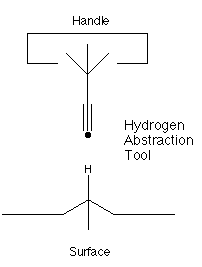Theoretical studies of a hydrogen abstraction tool for
nanotechnology
by Charles B. Musgrave, Jason K. Perry, Ralph
C. Merkle and William A. Goddard III.

Abstract
Processes that use mechanical positioning of
reactive species to control chemical reactions by either providing
activation energy or selecting between alternative pathways
will allow us to construct a wide range of complex
molecular structures. An example of such a process is
the abstraction of hydrogen from diamond surfaces by a radical
species attached to a mechanical positioning
device for synthesis of atomically precise diamond-like
structures. In the design of a nanoscale, site-specific
hydrogen abstraction tool, we suggest the use
of an alkynyl radical tip. Using ab initio
quantum-chemistry techniques including
electron correlation we model the abstraction of
hydrogen from dihydrogen,
methane, acetylene, benzene and isobutane by the acetylene
radical. Of these systems, isobutane serves as a good
model of the diamond (111) surface. By
conservative estimates, the abstraction barrier is small
(less than 7.7 kcal mol-1)
in all cases except for acetylene and zero in the case of
isobutane. Thermal vibrations at room temperature
should be sufficient to supply the small activation
energy. Several methods of creating the radical
in a controlled vacuum setting
should be feasible. Thermal, mechanical, optical and chemical
energy sources could all be used either to activate a precursor,
which could be used once and thrown away, or alternatively
to remove the hydrogen from the tip,
thus refreshing the abstraction tool for a second use. We
show how nanofabrication processes
can be accurately and inexpensively designed
in a computational framework.
The full article
is available on the web in HTML.
 See also High-Level
ab Initio Studies of Hydrogen Abstraction from Prototype Hydrocarbon Systems
by Berhane Temelso, C. David Sherrill, Ralph C. Merkle, and Robert A. Freitas
Jr., in J. Phys. Chem. A, 110 (38), 11160 -11173, 2006.
See also High-Level
ab Initio Studies of Hydrogen Abstraction from Prototype Hydrocarbon Systems
by Berhane Temelso, C. David Sherrill, Ralph C. Merkle, and Robert A. Freitas
Jr., in J. Phys. Chem. A, 110 (38), 11160 -11173, 2006. 